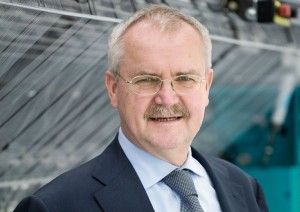European Textile Machinery Manufacturers Find Their Niche

As all stakeholders in the cotton and textile value chain have learned from the extreme volatility of the past few years, the fate of one sector can have a profound effect on all of the others.
While they are usually spared the direct impact from trends such as rising raw material costs and dwindling supplies, textile machinery manufacturers are no exception to that rule. When spinners and textile mills feel the pressure to contain costs and save resources, they turn to their machinery suppliers for help.
While much of the actual textile production has shifted to Asia, many of the top equipment manufacturers remain in their traditional locations in Europe. In January, the Cotton International team traveled to visit with the national associations in Italy (ACIMIT), Germany (VDMA) and Switzerland (Swissmem) to learn about the trends that are changing the face of the textile machinery industry.
An Alternative to Lowest-Cost Production
Among the most influential trends that has shaped the industry in recent years is the rise of equipment manufacturing in Asia. The much higher cost of living in Europe prevents manufacturers there from competing solely on a cost basis, so they have had to find a different value proposition.
“I believe that the epicenter of the textile business, as regards production and retail, will remain in Asia for at least the next 10 years or so,” says Dr. Lukas Sigrist, secretary general of Swissmem. “The strength of the Swiss industry, definitely, lies in its strong commitment to research and development. But this does not, on its own, guarantee success: The decisive key is the ability to transform innovative concepts into marketable products, something that requires entrepreneurial vision and the courage to take risks.”
Italian manufacturers, on the other hand, focus heavily on flexibility, according to Sandro Salmoiraghi, ACIMIT president. “In order to remain competitive, textile firms – especially those of the Western countries – must increasingly focus on innovation,” Salmoiraghi says. “Innovative products require innovative machinery and applied technology. The distinctive character of Italian supply is found in the flexibility that allows the Italian manufacturers to provide customers with technology solutions tailored to their specific needs.”
German equipment makers rely on one of the country’s most legendary traits: exceptional product life and world-class engineering that lower operating costs and provide a long-lasting return on investment. “The competitive advantages of German textile machinery become evident when one takes a look at the product life cycle of a machine and the accumulating costs,” says VDMA Chairman Fritz Mayer.
Finding Success in the Global Environment
Although all three associations say their members focus on slightly different areas of specialization, they all acknowledge that new capabilities and skills needed to be developed to ensure survival in the ultracompetitive marketplace.
Sustainability – both in terms of environmental stewardship and the ability of businesses to survive the pressure of mounting costs and shrinking margins – has become a primary goal for new product lines.
“Attention to sustainability has spread throughout the textile chain,” Salmoiraghi says. “Italian manufacturers want to contribute by offering sustainable solutions, attested by a green label that reports on the consumption of the machine and its primary carbon footprint.”
VDMA developed a sustainability initiative known as BLUecoMPETENCE for the same reason. “The initiative is the international trademark for sustainable solutions of the machinery sector and provides clear orientation for customers,” Mayer says.
One example is VDMA’s position paper, “Energy Efficient Textile Machinery,” in which the determining factors for a comparative assessment of the energy efficiency of textile machinery have been worked out. “The paper helps to make the discussion about efficiency criteria and carbon dioxide footprint more objective,” he adds.
Although sustainability is often understood to refer to environmental friendliness, it also includes to the ability to remain competitive and produce a reasonable profit in an increasingly challenging global marketplace.
Switzerland’s textile machinery manufacturers are well-prepared for that challenge, Dr. Sigrist asserts: “Doing business abroad and cooperating with foreign governments, companies and individuals are long-standing Swiss traditions.”









